

Early Civilizations:
Complex Societies of the New
and Old Worlds
Dr. Kathryn Denning
Anth 2150, Sept 2007 - Apr 2008
15 Jan 2008
Welcome back!
N.B. Quiz on Jan 23 in tutorial... on Chapters 12, 13, 14. See here for full review guidelines.
Plan for the day
1 Announcements.
Readings Schedule
The syllabus for Term 2 -- hand out.
Reading for Today, Jan 15
Fagan Chapter 13: Early Asian Civilizations
AND this online reading:
Jared Diamond, Why Did Human History Unfold Differently on Different Continents For the Last 13 000 Years?
www.edge.org/3rd_culture/diamond/diamond_p1.html
www.edge.org/3rd_culture/diamond/diamond_p2.html and subsequent pages.
Read this carefully... you'll be discussing it in tutorial tomorrow, on the 16th.
Reading for Next Week, Jan 22
Fagan Ch 14 "Maize, Pueblos, and Mound Builders"
Prehistory of Ontario www.adamsheritage.com/pre/preont1.htm (read expanded versions linked from left margin of that page)
Keep exploring this site as we examine ancient cultures: www.thebritishmuseum.ac.uk/compass/index.html
The museum assignment - hand out.
Note: The due date is now February 27th (instead of Feb 20th).
2 Lecture
Civilization continues!
Egypt
A little on Asia
and the Guns, Germs, and Steel Hypothesis
EGYPT
- Just a little to start. We'll do more in a couple of weeks' time.
Ozymandias.... King of Kings...

1817: English poet Percy Bysshe Shelley publishes his sonnet “Ozymandias”
I met a traveller from an antique land
Who said: Two vast and trunkless legs of stone
Stand in the desert. Near them, on the sand,
Half sunk, a shattered visage lies, whose frown,
And wrinkled lip, and sneer of cold command
Tell that its sculptor well those passions read
Which yet survive, stamped on these lifeless things,
The hand that mocked them, and the heart that fed:
And on the pedestal these words appear: ‘My name is Ozymandias, king of kings: Look on my works, ye mighty, and dispair!”
Nothing besides remains. Round the decay
Of that colossal wreck, boundless and bare,
The lone and level sands stretch far away.”
Accurate? Nope. Evocative? Definitely. Revealing of the English perception of Egypt as a place of dead history, surpassed by modern civilization? Just Maybe : )
A few things about Egypt
PLACE

 Nile: 6,825 km long!
Nile: 6,825 km long!


(Museum of Fine Arts, Boston)
below: Nile inundation
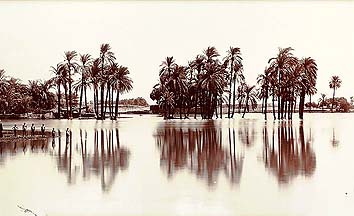
"
| This photo appears to have been taken during the time of the Nile's annual inundation. Rains in the highlands of Abysinnia swelled the Blue Nile, which met the White Nile at Khartoum and sent the rising, silt-laden waters north to cover the fields of Egypt. During the summer months Egypt disappeared beneath the brown waters, the whole of the land a vast sheet of water stretching from desert to desert, with the villages protruding like islands from the flood. In antiquity this was a time of increased navigation, festivals in honor of the inundation, booths and bowers on the edge of the swollen river, and festooned boats upon the waters. Since the building of the High Dam, the inundation no longer occurs in the Nile valley north of Aswan." |
"http://www-oi.uchicago.edu/OI/DEPT/PUB/CATALOG/LE2.2.html
ARCHAEOLOGY
Archaeological bonuses: burial rituals focused on deliberate preservation of bodies and burial goods; excellent natural preservation of sites because of hot, dry, sandy environment.
Other sources for information about the ancient Egyptians:
a) ancient historians, like Manetho, c. 300 BC, Egyptian historian and priest, whose works have not survived intact but are quoted in later historical works, e.g. by Jewish historian Josephus, first century AD.
b) ordinary documents
c) historical inscriptions on monuments themselves; pharaohs were constantly constructing their own histories, tracing lineages, recording their exploits, etc.
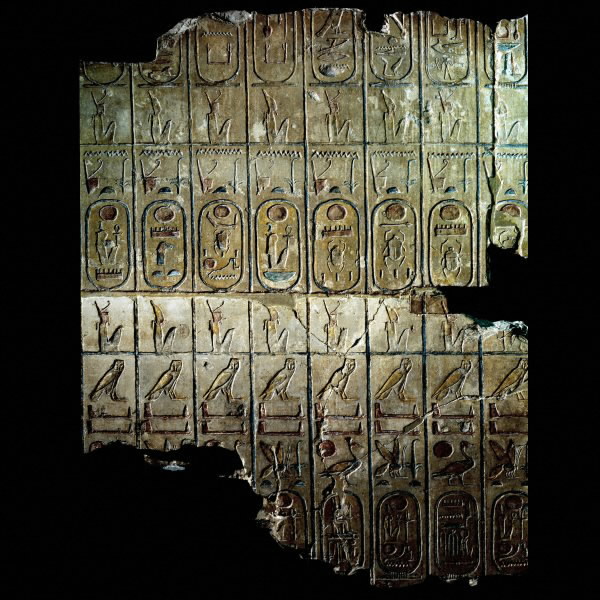
King List: 19th Dynasty, around 1250 BC, chronology of the rulers of Egypt so far, from a temple of Ramesses II.... but it is a selective list.
TIME
A good basic timeline: http://www.bbc.co.uk/history/ancient/egyptians/timeline.shtml
http://www.mfa.org/egypt/explore_ancient_egypt/learn_time.html
Predynastic Period: 5500 - 3100 BC.
0 Dynasty: Unification under Narmer and the Scorpion King.
First Dynasty 3050 - 2890 BC
Second Dynasty 2890 - 2686 BC
OLD KINGDOM: 2686 - 2181 BC. Centralised, unified government. Pharoah started to be divine.
Third Dynasty 2686 - 2613 BC: Djoser builds Step Pyramid at Saqqara.
Fourth Dynasty 2613 - 2498 BC: Khufu (Great Pyramid), Khafre (Sphinz, Second pyramid) and Menkaure build pyramids at Giza.
Fifth Dynasty 2498 - 2345 BC
Sixth Dynasty 2345 - 2181 BC
First Intermediate Period: 7th - 11th Dynasties 2181 - 2055 BC. A mess!
MIDDLE KINGDOM: 2055 - 1650 BC. Unified, prosperous, foreign trade, big building projects.
Mid-Eleventh Dynasty (Mentuhotep I) 2060 - 1991 BC
Twelfth Dynasty 1991 - 1782 BC
Thirteenth Dynasty 1782 - 1650 BC (first half only)
Second Intermediate period 1650 - 1570 BC. Periods of Hyksos rule.
New Kingdom: 1570 - 1070 BC. Again, centralized, unified government.
Eighteenth Dynasty 1570 - 1293 BC: a renaissance of art and building. Tuthmosis (multiple), Hapshetsut, Akhenaten, Tutankhamun
Nineteenth Dynasty 1293 - 1185 BC: Ramesses I, II, III, Seti I and II
Twentieth Dynasty 1185 - 1070 BC: Ramesses IV-XI. breakdown of government. Officials rob tombs and priests assume secular power.
Third Intermediate Period: 1070 - 664 BC. Includes periods of Libyan and Kushite rule.
Late Period: 664-332 BC: Includes periods of Persian rule.
Macedonian and Ptolemaic Period: 332 - 3O BC. Alexander the Great conquered Egypt in 332 BC, built Alexandria. His general Ptolemy I ultimately succeeded him -- and 14 more Ptolemies after that. Rosetta Stone. Cleopatra VII, daughter and co-regent of Ptolemy XII, and sister/co-regent of Ptolemy XIV, ruled Egypt at the end. (Romantic liaisons with Roman rulers Julius Caesar, Marc Anthony.... Rome declared war on Cleopatra/Egypt in 32 BC, and in 30 BC, Octavian, Julius Caesar's adopted son (later known as Roman Emperor Augustus), conquered Egypt and proclaimed himself Pharaoh. Egypt then part of the Roman Empire.
Roman rule: 30 BC - AD 395
Coptic Egypt: Christianity arrived in Egypt around 50AD with St. Mark, and a Christian community started in Alexandria. Eventually there were many (60?) Christian monasteries in Egypt and the religion was generally widespread. Difficulties came when the Romans under Diocletian started to suppress other religions, particularly Christianity. Much martyrdom for a period of about 30 years, 284-313 AD, until the Romans decided on a policy of tolerance again. Christianity continues in parts of Egypt to the present day.
Byzantine: AD 395-640 Ruled from Constantinople, predominantly Christian.
Islamic/Arab Period (Caliphate) Egypt: 640 AD onwards. Ruled from Damascus and from Baghdad.
Ottoman Period: AD 1517-1805. Ruled from Turkey.
Napoleon's expedition: circa 1800, short-lived.
Khedeval Period: AD 1805-1914
British Protectorate: AD 1914-1922
Monarchy: AD 1922-1953
Republic: AD 1953-
Harappan civilization, specifically at Harappa and Mohenjodaro
Early Civilizations in the Indus Valley
First, knowing where we are...

Note: India, Africa, Asia, Europe.
Arabian Sea, Indian Ocean, Bay of Bengal, Indus and Ganges.
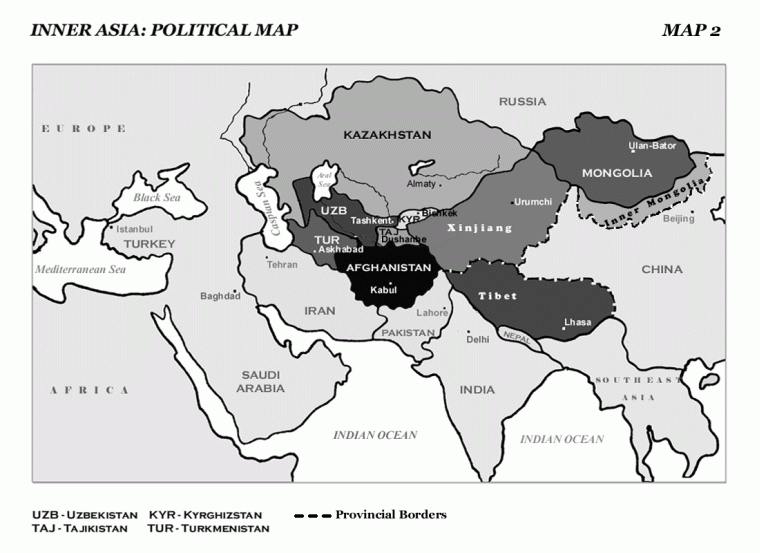
Note the current political boundaries.
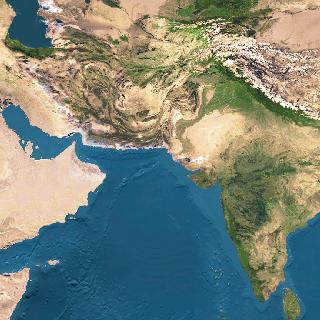
Note the geographical features: Himalayas, Ganges R, Indus R.
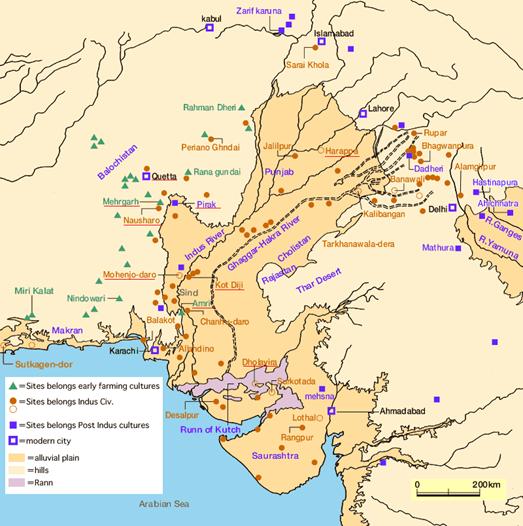
Note: Extent of alluvial plain, modern cities like Karachi, Lahore, Islamabad, Kabul, as well as Indus civilization cities like Mohenjodaro, Harappa
Remember...geography matters when we are considering the origins and development of ancient civilizations.
Some key features of Harappan civilization
Timing:
-started by 3000 BC
-"mature Harappan" 2500-2050 BC
- collapse c. 2000 BC.
Main sites:
Mehrgarh (v. early, starting 6000 BC, domesticated plants and animals (wheat, barley, sheep, goats, cattle), village with strong regional trade
Harappan, e.g. Nindowari site, 2600-2200 BC.
Mohenjodaro and Harappa, Pakistan
Built on artificial mounds above the flood plains - huge effort
Cities: Big! 23 500 at Harappa, up to 40 000 for Mohenjodaro
Mohenjodaro the largest, six times the area of Harappa, rebuilt at least 9 times
Harappa and Mohenjodaro have similar layouts... citadel, perimeter wall with towers, houses with multiple stories, bazaar districts
Don't know names of rulers... not ostentatious... no "priestly pomp" or "lavish public display"... no "ardent militarism" or glorification.
Technology and Trade: Craft specialization
Political and Social Organization and Religion - Complex but not well understood.
Writing - not well understood.
Some of the symbols are suggestive of later Hinduism


Examples of the undeciphered Indus Valley script.
The "Unicorn Seal" of fired steatite, from Mohenjo-daro, c. 2000 BCE and another seal impression.
Images borrowed from http://www.harappa.com/seal/seal1.html and http://www.harappa.com/seal/seal3.html

Dancer figurine, bronze. Mohenjodaro. (10.2 cm high)
e.g.s of Indus script: http://www.harappa.com/indus/31.html
http://www.harappa.com/script/
Tour the Indus Valley! www.harappa.com/indus/indus0.html
www.harappa.com/indus/slideindex.html
-------------------------------------
Angkor
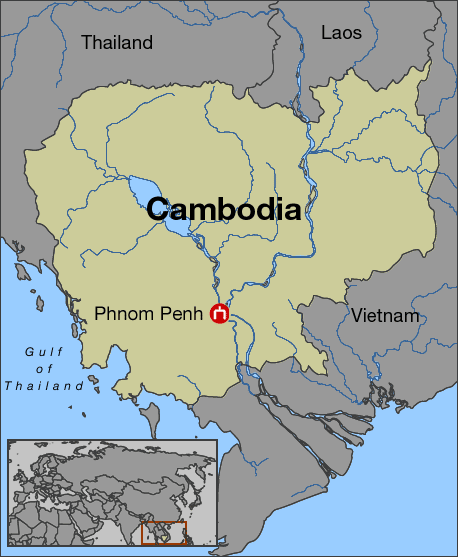
Influence from India and China
Very basic timeline here: http://mcel.pacificu.edu/as/students/straussj2/timeline.html
and more here: http://news.bbc.co.uk/2/hi/asia-pacific/country_profiles/1244006.stm
Cambodia is currently devastated economically and relies very heavily on tourism at places like Angkor Wat. Huge problem with illicit antiquities trade. (We'll return to this case study.)
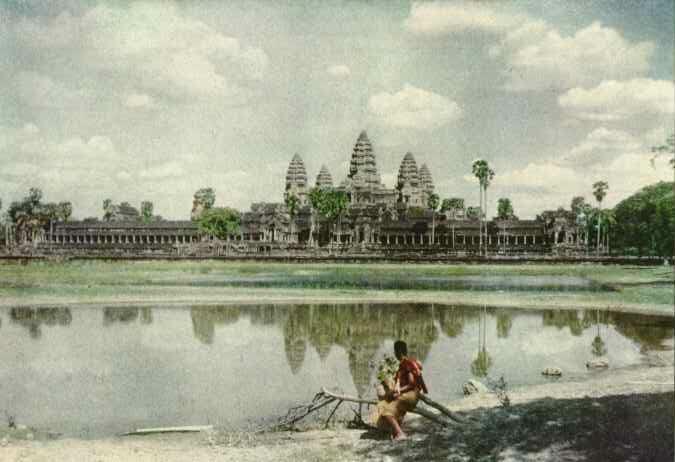
Photo of Angkor Wat from the 1920s. Temple, mausoleum, and astronomical observatory.
Angkor state: AD 802-1430
n.b. Divine kings e.g. Jayavarman II
"Khmers' unique form of kingship produced a society that carried the cult of wealth, luxury, and divine monarchy to amazing extremes." Supported by extensive lower class/slaves.
The building of Angkor Wat represents Khmer religious beliefs at that time
Angkor Wat: Temple, mausoleum, and astronomical observatory. The largest religious building in the world. Huge complex. Belief system directly represented in the architecture. Tallest tower represents summit of Mt. Meru (cosmic mountain), other towers represent its other peaks. Decorations: warriors, celestial maidens.
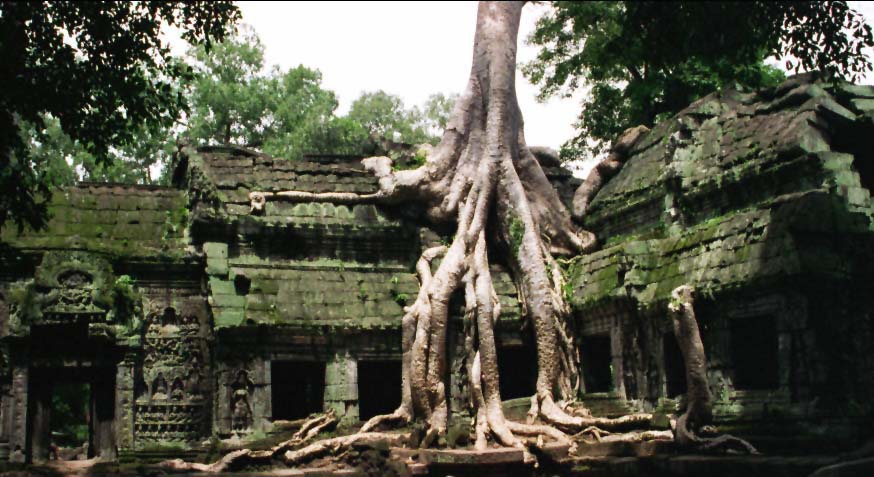
Ta Phrom, in the Angkor complex
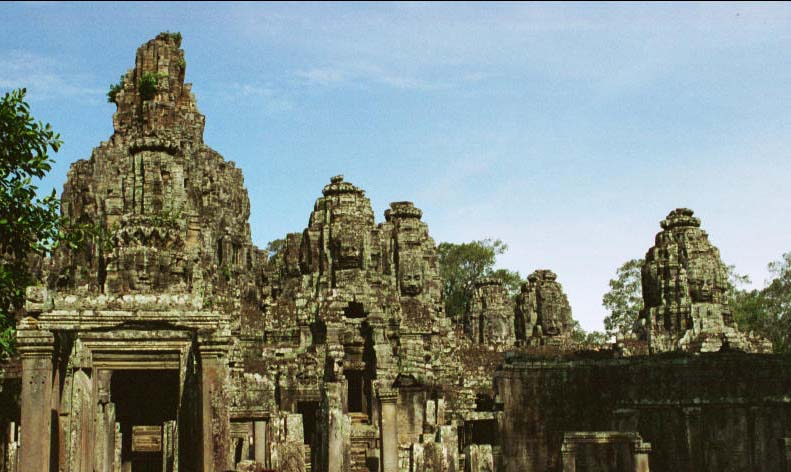
Bayon temple: faces pointing in cardinal directions
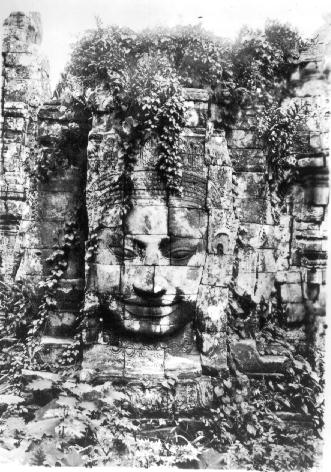
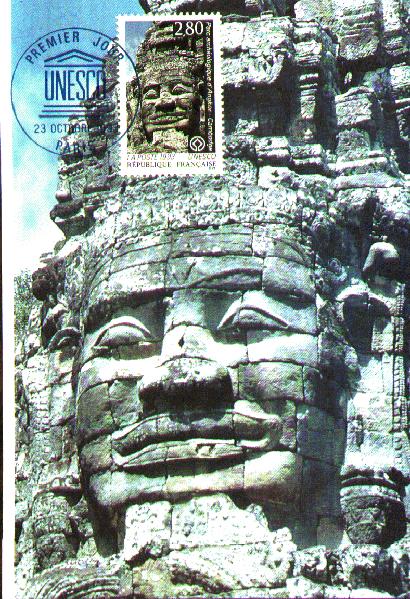
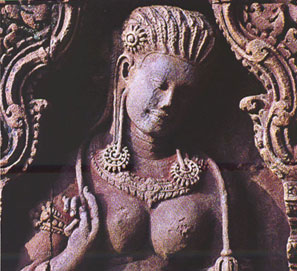
One of the huge questions about civilizations... How did things come to be this way? That is, a world with profound inequalities. Why did wealth and power come to be distributed as they now are, rather than in some other way?
WE TURN TO JARED DIAMOND, 'GUNS GERMS AND STEEL' TO FIND OUT. (We will return to Diamond again later in the course. This video discusses the first part of his theory.
Key points:
- Yali's question -- why do white men have so much cargo, and New Guineans so little? (cargo = material objects)
- scenes from First Contact in New Guinea in 1930s (film)... white men's 'cargo' was, initially, almost magical to the New Guineans
- New Guineans are very smart and resourceful... so why didn't they develop civilization?
- to find out... we have to go back to the time when no-one was living in civilizations... and to find out why then some changed, i.e. started building pyramids, when others continued to live as they always had.
- 13 000 years ago, Middle East wasn't arid.
- hunting requires intelligence and skill but is a great lifestyle (as seen in PNG) but has certain limitations... not reliable
- foraging/gathering tends to supply more calories/ is more reliable and productive, but it is also a lot of work (e.g. sago) and cannot usually support a large population
- in the Middle East... barley and wheat grew wild... more abundant and more nutritious than sago.
- climate change 12 500bp - temps dropped, became drier... Middle East... environmental collapse.... 1000-year drought.... had to change the way they lived... e.g. site of Dhra - 40/50 people, settled 11 500 ybp... earliest known storage of wheat and barley... thus actually selecting some plants over others... thus beginning the process of domestication
- China (rice), Americas (corn, squash, beans), Africa (sorghum, millet, yams)
- but this process couldn't have worked just anywhere... in some places like New Guinea, even where farming has been going on for 10 000 years, you couldn't store the food, and it wouldn't just grow from seeds, and it was lower in protein (e.g. taro)
- so... farming was crucial to the foundations of inequality, but it also mattered what kind of farming it was. The people around the world who had access to the most productive crops became the most productive farmers - geographic luck.
The consequences were huge.
(more in tutorial tomorrow!)